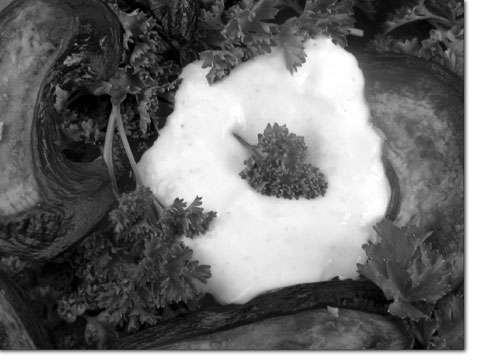| ||
Operation Enduring Garlic
by Chef Boy Ari Last week, a suicide car bomb ripped through a crowded produce market in Hilla, Iraq. A city block of stalls, vendors and shoppers was turned into twisted wreckage. Eggplant, parsley and other hard-won produce lay in pools of blood. I read that in the newspaper on Saturday morning, as I drank my coffee and ate my apricot bar, which was smothered in vanilla yogurt. What a lovely breakfast. Except, that’s my blood down there, at the produce market on the other side of the world. I left the house and went downtown to the farmers’ market, imagining what it would be like to have our market bombed. For the fourth time in four weeks, it was raining at the market; cabbage and carrots glowed neon in the damp air. Farmers were resigned to their rainy fates, yet cheerful, because this is the time of year farmers get happy. In a few weeks, once the last of the harvest is in and the fields are put to bed and the garlic is planted, they will finally get some sleep. I was shopping for garlic to plant in my garden, because now is the time. You push garlic cloves into the ground in October, and they send up big green shoots in spring. I like to grow enough garlic that, come fall, I can plant a big patch for next year and still have enough to eat all winter. But somehow, last year’s crop came up a little short. Which is why I was cruising the rainy market, open for some garlic to catch my eye. The eye-catcher turned out to be a type called Music Porcelain, a white-skinned, hardneck variety with big cloves. I always go for hardneck garlic, which you can distinguish by the stout stem in the middle of all the cloves. The other major type of garlic is called softneck, which has a pliable central stalk that’s better for braiding. Hardneck garlic usually has a more symmetrical layout of cloves, with fewer randomly placed small ones. Hardneck is easier to peel, too, which really counts in the kitchen. Softneck is often preferred by growers because it can store a bit longer. But hardneck stores as long as I need it — well into the onset of next year’s crop. The rivalry between hardneck and softneck garlic is nonviolent and friendly, and nobody has to lose — except the suckers who grow softneck, whose fingers get covered with sticky shreds of garlic wrapper every time they peel their little cloves. As I was leaving the market with my bag of garlic, I passed Wrathful Steve’s stall. He was deep in conversation with a customer, and he looked sad — maybe it was the conversation, or the rain, or maybe it was the war. Wrathful Steve motioned me to take an eggplant, which I did. Like war, the planting of garlic is both simple and complex. In its simplest form, you break apart a head of garlic and plant the individual cloves 5 to 8 inches apart, with the flat, scabby spot oriented downward. Plant it deep enough so that there is about an inch of dirt over the top of each clove. Do this in October or early November, before the ground freezes — but not too early. You want the roots to get established before the ground freezes, but you don’t want green sprouts above the ground until springtime. You want good soil, of course, and full sun. You should mulch your garlic patch with leaves or straw — just make sure the little shoots can make it through the mulch in springtime. Keep your patch well-watered when the spring rains end. Pick off the garlic flowers when they sprout so the bulbs will grow bigger. Each planted clove will grow into a whole head of garlic, but beyond this simple truth is a world of nuance and art. I took home my new garlic, and Wrathful Steve’s eggplant, and made an Iraqi dish that someone at that blown-up market might have been planning, a dish of browned eggplant and garlic yogurt called Misaqua’at Betinjan bil Laban. Cut the eggplant into ¼ inch slices and soak them in warm salted water (2 teaspoons of salt per quart) for half an hour. Drain the slices, pat them dry, toss them in olive oil, sprinkle with flour, and bake at 400 degrees for about half an hour, turning once, until browned. Mix together 1 cup yogurt, 2 (or more) cloves of pressed or grated garlic, ½ teaspoon salt, a dash of cumin and a dash of coriander. Arrange your browned eggplant on a platter, garnished with parsley. Spoon the yogurt sauce over the eggplant and serve with peace in your heart. •
|


